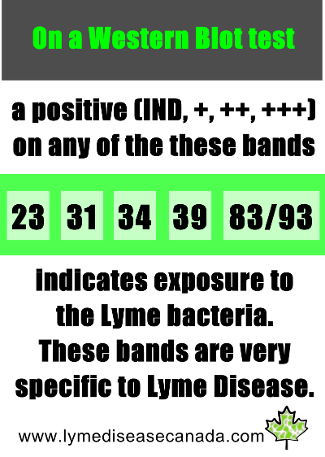
Samples of IgeneX Test Results
What do IgeneX Western Blot results look like and what do they mean?
Chances are, if you are picking up your results from your family doctor, he or she will not know how to read the results of the blood test.
Here is the most thorough information I have found courtesy of the Lyme Disease Association of Australia:
Interpreting Lyme disease blood tests
The US Centre for Disease Control (CDC) has stipulated that certain “bands” in the Western Blot test must be positive in order for a Lyme test to be declared positive – the problem is that these bands were chosen for statistical, rather than diagnostic criteria. For example, the more specific bands for Lyme disease (bands 31 and 34) were excluded from the CDC criteria because they were used to create the Lyme disease vaccine (which is no longer available), thus eliminating valuable testing data. If you have not received the Lyme disease vaccine and you test positive (“+”) or indeterminate (“IND”) to bands 31 and 34, you probably have Lyme disease. The CDC testing criteria actually includes a number of bands which are not specific to Lyme disease, which increases the chances of a false-negative, but only if the CDC criteria for test reporting is used.
What is the difference between “+”, “++”, “+++” and “IND”?
These are the level to which the laboratory technician can see the immune response to the specific part of the bacteria. Both “++” and “+++” results are very rare, and show a strong immune response to the Lyme disease bacteria. If a patient’s immune response is compromised (as it is in most Lyme disease patients and particularly in patients with neurological, late stage or severe Lyme Disease), a “IND” result is a weak positive immune response to Lyme disease and should be treated as a positive result. After treatment, many patients who are retested return stronger results, as their immune system has been able to mount a more effective response against the Lyme disease bacteria.
What is the difference between the Western Blot IgG and IgM tests?
The IgM is generally regarded as the body’s response to recent exposure to Lyme disease. IgG is generally regarded as the body’s response over time (i.e. longer term) to Lyme disease. Because the immune system is compromised in Lyme disease, often the IgG and IgM responses can become mixed up.
How do I interpret my Lyme disease blood test results?
Currently there are 9 identified bands specific to Lyme disease – 18, 23-25, 31, 34, 37, 39, 83 and 93. A “+” or “IND” to one of these bands is considered a positive result. A “+” or “IND” to two or more of these bands is considered a strong positive result.
Other bands on the Western Blot report such as 22, 28, 30, 41, 45, 58, 66, & 73, all add significant weight to the result, but at this stage are not necessarily considered as absolute specific for Lyme bacteria.
NOTE : It must be stressed that a Lyme disease diagnosis is not based on a blood test result, but is rather based on medical history and current presenting symptoms – blood tests can assist in diagnosis, but should not be used to base a diagnosis on. Also, almost all Lyme disease patients have co-infections such as Ehrlichia, Rickettsia, Babesia, Bartonella, Mycoplasma Fermentans, Chlamydia Pneumonia, etc – these have their own testing and diagnostic problems, but should be considered in the diagnosis and treatment of a patient with Lyme disease.
Information regarding the bands
- 31 (also written as 31kDa) – is the outer surface protein A (ospA) – this is a classic Lyme disease band, used in the Lyme disease vaccine.
- 34 (also written as 34kDa) – this is the outer surface protein B (ospB) – this is also a hallmark Lyme disease antibody, but is excluded from CDC criteria because it was used in the Lyme vaccine which is longer available.
- 23-25 (also written as 23-25 kDa) – these are the outer surface protein C.
- Patients that have a 31 or 34, or 23-25 band have a 97% response rate to the correct antibiotic treatment in conjunction with correct treatment for co-infections.
- Only one of these Borrelia burgdorferi genus specific bands (18, 23, 31, 34, 37, 39, 83 and 93) is needed to confirm that there is lab evidence of exposure to the Borrelia burgdorferi spirochete and can confirm a clinical diagnosis of Lyme disease.